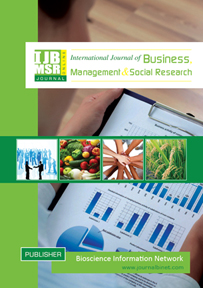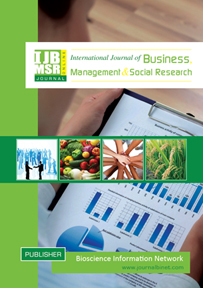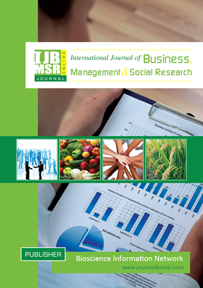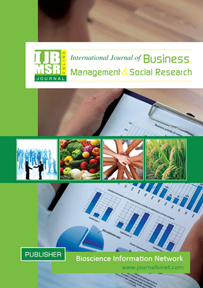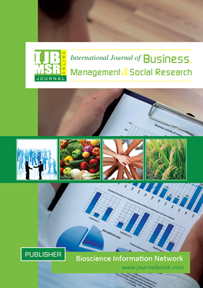International Journal of Business Management and Social Research
Volume 11, Issue 01 | Year of publication: 2021
Article Type: Questionnaire survey paper | No. 61, 2021 | Country: Phillippines | pp. 577-584 | Open Access
Title: Impact of online technology on the life of the Aeta native in the Northern Philippines
Author: Aringo, R. P. and Diego, A. A.
DOI: http://dx.doi.org/10.18801/ijbmsr.110121.61
Title: Impact of online technology on the life of the Aeta native in the Northern Philippines
Author: Aringo, R. P. and Diego, A. A.
DOI: http://dx.doi.org/10.18801/ijbmsr.110121.61
Title: Impact of online technology on the life of the Aeta native in the Northern Philippines
Abstract
The Aeta tribe is one of the most widespread ethnic groups in the Philippines. They are known for their distinct identities and culture, which reflect deep-rooted traditions from their ancestors. Changing time and the emergence of new technologies have impacted the way Aeta lives and created unique changes for establishing and maintaining relationships among the members of the tribes. This research aimed to explore the influence of online technology on the life of selected Aeta natives in the Province of Pampanga. It used Interpretative Phenomenological Analysis (IPA), a qualitative research approach where researchers carefully explored how participants made sense of their experiences. Results of the study revealed the major themes on the impact of online technology on the life of Aetas: (1) facilitate connection and maintain meaningful ties; (2) mindfulness of the gadget use; and (3) nurtures life. In conclusion, Aeta used online technology to assist them in their lives, making it less demanding yet meaningful, that there is no attempt to modernize their identity and achieve personal control with minimal reliance on online technology. Online technology cannot ultimately change the distinctiveness of Aetas’ cohesive behavior.
Key Words: Internet, social media, indigenous people, ethnicity, culture and gadget use.
Abstract
The Aeta tribe is one of the most widespread ethnic groups in the Philippines. They are known for their distinct identities and culture, which reflect deep-rooted traditions from their ancestors. Changing time and the emergence of new technologies have impacted the way Aeta lives and created unique changes for establishing and maintaining relationships among the members of the tribes. This research aimed to explore the influence of online technology on the life of selected Aeta natives in the Province of Pampanga. It used Interpretative Phenomenological Analysis (IPA), a qualitative research approach where researchers carefully explored how participants made sense of their experiences. Results of the study revealed the major themes on the impact of online technology on the life of Aetas: (1) facilitate connection and maintain meaningful ties; (2) mindfulness of the gadget use; and (3) nurtures life. In conclusion, Aeta used online technology to assist them in their lives, making it less demanding yet meaningful, that there is no attempt to modernize their identity and achieve personal control with minimal reliance on online technology. Online technology cannot ultimately change the distinctiveness of Aetas’ cohesive behavior.
Key Words: Internet, social media, indigenous people, ethnicity, culture and gadget use.
HOW TO CITE THIS ARTICLE:
MLA
Aringo and Diego “Impact of online technology on the life of the Aeta native in the Northern Philippines”. International Journal of Business, Management and Social Research 11(01) (2021): 577-584.
APA
Aringo, R. P. and Diego, A. A. (2021). Impact of online technology on the life of the Aeta native in the Northern Philippines. International Journal of Business, Management and Social Research, 11(01), 577-584.
Chicago
Aringo, R. P. and Diego, A. A. “Impact of online technology on the life of the Aeta native in the Northern Philippines”. International Journal of Business, Management and Social Research, 11(01) (2020): 577-584.
Harvard
Aringo, R. P. and Diego, A. A. 2021. Impact of online technology on the life of the Aeta native in the Northern Philippines. International Journal of Business, Management and Social Research, 11(01) pp. 577-584.
Vancouver
Aringo, RP and Diego, AA. Impact of online technology on the life of the Aeta native in the Northern Philippines. International Journal of Business, Management and Social Research. 2021 May 11(01), 577-584.
MLA
Aringo and Diego “Impact of online technology on the life of the Aeta native in the Northern Philippines”. International Journal of Business, Management and Social Research 11(01) (2021): 577-584.
APA
Aringo, R. P. and Diego, A. A. (2021). Impact of online technology on the life of the Aeta native in the Northern Philippines. International Journal of Business, Management and Social Research, 11(01), 577-584.
Chicago
Aringo, R. P. and Diego, A. A. “Impact of online technology on the life of the Aeta native in the Northern Philippines”. International Journal of Business, Management and Social Research, 11(01) (2020): 577-584.
Harvard
Aringo, R. P. and Diego, A. A. 2021. Impact of online technology on the life of the Aeta native in the Northern Philippines. International Journal of Business, Management and Social Research, 11(01) pp. 577-584.
Vancouver
Aringo, RP and Diego, AA. Impact of online technology on the life of the Aeta native in the Northern Philippines. International Journal of Business, Management and Social Research. 2021 May 11(01), 577-584.
Article Type: Questionnaire survey paper | No. 62, 2021 | Country: Bangladesh | pp. 585-594 | Open Access
Title: Teaching-learning environment of private educational institute: A case study on Ispahani Public School and College, Chittagong, Bangladesh
Author: Hossain, M. K., and Jahan, N.
DOI: http://dx.doi.org/10.18801/ijbmsr.110121.62
Title: Teaching-learning environment of private educational institute: A case study on Ispahani Public School and College, Chittagong, Bangladesh
Author: Hossain, M. K., and Jahan, N.
DOI: http://dx.doi.org/10.18801/ijbmsr.110121.62
Title: Teaching-learning environment of private educational institute: A case study on Ispahani Public School and College, Chittagong, Bangladesh
Abstract
This qualitative/descriptive study aimed to explore the teaching-learning environment of Ispahani Public School and College (IPSC), Chittagong. The study was conducted by using a questionnaire survey and semi structured interviews. The study revealed that the Teacher-Student ratio of IPSC was 1: 32.7. The result of public examination represents that the entire educational environment and performance of students were satisfactory. All of the teachers (100%) opined very likely on regular teaching-learning activities of IPSC. Also, most of the students were satisfied with the educational environment. The responses of teachers-students on strong and weak points of IPSC showed the improvement of the institute. Most of the teachers (80%) followed the lecture method while conducting their classes. The rules of discipline and maintenance were environmentally friendly. The study recommended improving some internal problems (eg. lack of pedagogical knowledge, insufficient supply of teaching aids, lack of positive reinforcement, teacher centered learning etc.) and proper training for teachers. It will also be helpful for the authorities of private educational institute of Bangladesh.
Key Words: Teaching, Learning, Institute, Environment, Private and IPSC.
Abstract
This qualitative/descriptive study aimed to explore the teaching-learning environment of Ispahani Public School and College (IPSC), Chittagong. The study was conducted by using a questionnaire survey and semi structured interviews. The study revealed that the Teacher-Student ratio of IPSC was 1: 32.7. The result of public examination represents that the entire educational environment and performance of students were satisfactory. All of the teachers (100%) opined very likely on regular teaching-learning activities of IPSC. Also, most of the students were satisfied with the educational environment. The responses of teachers-students on strong and weak points of IPSC showed the improvement of the institute. Most of the teachers (80%) followed the lecture method while conducting their classes. The rules of discipline and maintenance were environmentally friendly. The study recommended improving some internal problems (eg. lack of pedagogical knowledge, insufficient supply of teaching aids, lack of positive reinforcement, teacher centered learning etc.) and proper training for teachers. It will also be helpful for the authorities of private educational institute of Bangladesh.
Key Words: Teaching, Learning, Institute, Environment, Private and IPSC.
HOW TO CITE THIS ARTICLE:
MLA
Hossain and Jahan “Teaching-learning environment of private educational institute: A case study on Ispahani Public School and College, Chittagong, Bangladesh”. International Journal of Business, Management and Social Research 11(01) (2021): 585-594.
APA
Hossain, M. K., and Jahan, N. (2021). Teaching-learning environment of private educational institute: A case study on Ispahani Public School and College, Chittagong, Bangladesh. International Journal of Business, Management and Social Research, 11(01), 585-594.
Chicago
Hossain, M. K. and Jahan, N. “Teaching-learning environment of private educational institute: A case study on Ispahani Public School and College, Chittagong, Bangladesh”. International Journal of Business, Management and Social Research, 11(01) (2021): 585-594.
Harvard
Hossain, M. K. and Jahan, N. 2021. Teaching-learning environment of private educational institute: A case study on Ispahani Public School and College, Chittagong, Bangladesh. International Journal of Business, Management and Social Research, 11(01) pp. 585-594.
Vancouver
Hossain, MK, Jahan, N. Teaching-learning environment of private educational institute: A case study on Ispahani Public School and College, Chittagong, Bangladesh. International Journal of Business, Management and Social Research. 2021 November, 11(01), 585-594.
MLA
Hossain and Jahan “Teaching-learning environment of private educational institute: A case study on Ispahani Public School and College, Chittagong, Bangladesh”. International Journal of Business, Management and Social Research 11(01) (2021): 585-594.
APA
Hossain, M. K., and Jahan, N. (2021). Teaching-learning environment of private educational institute: A case study on Ispahani Public School and College, Chittagong, Bangladesh. International Journal of Business, Management and Social Research, 11(01), 585-594.
Chicago
Hossain, M. K. and Jahan, N. “Teaching-learning environment of private educational institute: A case study on Ispahani Public School and College, Chittagong, Bangladesh”. International Journal of Business, Management and Social Research, 11(01) (2021): 585-594.
Harvard
Hossain, M. K. and Jahan, N. 2021. Teaching-learning environment of private educational institute: A case study on Ispahani Public School and College, Chittagong, Bangladesh. International Journal of Business, Management and Social Research, 11(01) pp. 585-594.
Vancouver
Hossain, MK, Jahan, N. Teaching-learning environment of private educational institute: A case study on Ispahani Public School and College, Chittagong, Bangladesh. International Journal of Business, Management and Social Research. 2021 November, 11(01), 585-594.
Article Type: Questionnaire survey paper | No. 63, 2021 | Country: Bangladesh | pp. 595-601 | Open Access
Title: Profitability analysis of potato cultivation: A study in Munshiganj district of Bangladesh
Author: Mukul, A. Z. A. and Parvin, M. M.
DOI: http://dx.doi.org/10.18801/ijbmsr.110121.63
Title: Profitability analysis of potato cultivation: A study in Munshiganj district of Bangladesh
Author: Mukul, A. Z. A. and Parvin, M. M.
DOI: http://dx.doi.org/10.18801/ijbmsr.110121.63
Title: Profitability analysis of potato cultivation: A study in Munshiganj district of Bangladesh
Abstract
The overall objective of the study was to analyze the profitability of potato cultivation in some selected areas of Munshiganj district. For this study, 100 respondents with different income groups were selected as sample size purposively. Data were collected through farm survey by using a suitable pre-tested questionnaire in February-March, 2018. The study found that potato production was lucrative. Total cost of potato growing was BDT Tk. 144584.41 and the gross return amount was BDT Tk. 254000.00 per hectare. The net return from potato production was BDT Tk. 109415.49 per hectare. Undiscounted Benefit Cost Ratio (BCR) was found at 1.78 and 1.75. Potato is not an outstanding source of energy yet a good source of high quality protein. Potato is a rich source of vitamin C; it is rich in important minerals. These were grouped into economic and technical, marketing and storage problems. Though farmers were facing some acute problems such as low market prices of potato and high input prices, it would not hinder the expansion of potato production due to its huge demand.
Key Words: Potato, Profitability, Production, Benefit Cost Ratio and Problems.
Abstract
The overall objective of the study was to analyze the profitability of potato cultivation in some selected areas of Munshiganj district. For this study, 100 respondents with different income groups were selected as sample size purposively. Data were collected through farm survey by using a suitable pre-tested questionnaire in February-March, 2018. The study found that potato production was lucrative. Total cost of potato growing was BDT Tk. 144584.41 and the gross return amount was BDT Tk. 254000.00 per hectare. The net return from potato production was BDT Tk. 109415.49 per hectare. Undiscounted Benefit Cost Ratio (BCR) was found at 1.78 and 1.75. Potato is not an outstanding source of energy yet a good source of high quality protein. Potato is a rich source of vitamin C; it is rich in important minerals. These were grouped into economic and technical, marketing and storage problems. Though farmers were facing some acute problems such as low market prices of potato and high input prices, it would not hinder the expansion of potato production due to its huge demand.
Key Words: Potato, Profitability, Production, Benefit Cost Ratio and Problems.
HOW TO CITE THIS ARTICLE:
MLA
Mukul and Parvin “Profitability Analysis of Potato Cultivation: A Study in Munshiganj District of Bangladesh”. International Journal of Business, Management and Social Research 11(01) (2021): 595-601.
APA
Mukul, A. Z. A. and Parvin, M. M. (2021). Profitability Analysis of Potato Cultivation: A Study in Munshiganj District of Bangladesh. International Journal of Business, Management and Social Research, 11(01), 595-601.
Chicago
Mukul, A. Z. A. and Parvin, M. M. “Profitability Analysis of Potato Cultivation: A Study in Munshiganj District of Bangladesh”. International Journal of Business, Management and Social Research, 11(01) (2021): 595-601.
Harvard
Mukul, A. Z. A. and Parvin, M. M. 2021. Profitability Analysis of Potato Cultivation: A Study in Munshiganj District of Bangladesh. International Journal of Business, Management and Social Research, 11(01) pp. 595-601.
Vancouver
Mukul, AZA and Parvin, MM. Profitability Analysis of Potato Cultivation: A Study in Munshiganj District of Bangladesh. International Journal of Business, Management and Social Research. 2021 December, 11(01), 595-601.
MLA
Mukul and Parvin “Profitability Analysis of Potato Cultivation: A Study in Munshiganj District of Bangladesh”. International Journal of Business, Management and Social Research 11(01) (2021): 595-601.
APA
Mukul, A. Z. A. and Parvin, M. M. (2021). Profitability Analysis of Potato Cultivation: A Study in Munshiganj District of Bangladesh. International Journal of Business, Management and Social Research, 11(01), 595-601.
Chicago
Mukul, A. Z. A. and Parvin, M. M. “Profitability Analysis of Potato Cultivation: A Study in Munshiganj District of Bangladesh”. International Journal of Business, Management and Social Research, 11(01) (2021): 595-601.
Harvard
Mukul, A. Z. A. and Parvin, M. M. 2021. Profitability Analysis of Potato Cultivation: A Study in Munshiganj District of Bangladesh. International Journal of Business, Management and Social Research, 11(01) pp. 595-601.
Vancouver
Mukul, AZA and Parvin, MM. Profitability Analysis of Potato Cultivation: A Study in Munshiganj District of Bangladesh. International Journal of Business, Management and Social Research. 2021 December, 11(01), 595-601.
Volume 11, Issue 02 | Year of publication: 2022
Article Type: Questionnaire survey paper | No. 64, 2022 | Country: Bangladesh | pp. 602-608 | Open Access
Title: Determinants of energy consumption in rural households of India
Author: Rasha, R. K., Kazal, M. M. H., Mondal, R. K. and Sujan, M. H. K.
DOI: http://dx.doi.org/10.18801/ijbmsr.110222.64
Title: Determinants of energy consumption in rural households of India
Author: Rasha, R. K., Kazal, M. M. H., Mondal, R. K. and Sujan, M. H. K.
DOI: http://dx.doi.org/10.18801/ijbmsr.110222.64
Title: Determinants of energy consumption in rural households of India
Abstract
The relation between rural household characteristics and household energy consumption demand and expenditures indicates a signal for continuous production and supply of energy to enhance rural development. This study was aimed to identify the determinants of energy consumption in rural households of India. A total of 7416 observations was used from the Indian household survey data 2018. In this study, Ordinary Least Square (OLS) method was used to attain the objectives. Findings of the study evident that the household principal decision maker, indebtedness of the household, household size and irrigation pump used by the household for cultivation purposes were the prime indicators that significantly affect the energy consumption expense of the rural household. Of the above-mentioned indicators, household principal decision maker, household size and irrigation pump used by the household positively affect the energy consumption expenditure, whereas indebtedness of the household had a negative effect. All those factors are essential to determine the energy consumption demand and ensure sustained energy production at the rural level to enhance rural development. This rural development, in turn, will contribute to alleviating poverty and brings up economic development of the country.
Key Words: Energy policy, Household characteristics, Renewable energy and Rural development.
Abstract
The relation between rural household characteristics and household energy consumption demand and expenditures indicates a signal for continuous production and supply of energy to enhance rural development. This study was aimed to identify the determinants of energy consumption in rural households of India. A total of 7416 observations was used from the Indian household survey data 2018. In this study, Ordinary Least Square (OLS) method was used to attain the objectives. Findings of the study evident that the household principal decision maker, indebtedness of the household, household size and irrigation pump used by the household for cultivation purposes were the prime indicators that significantly affect the energy consumption expense of the rural household. Of the above-mentioned indicators, household principal decision maker, household size and irrigation pump used by the household positively affect the energy consumption expenditure, whereas indebtedness of the household had a negative effect. All those factors are essential to determine the energy consumption demand and ensure sustained energy production at the rural level to enhance rural development. This rural development, in turn, will contribute to alleviating poverty and brings up economic development of the country.
Key Words: Energy policy, Household characteristics, Renewable energy and Rural development.
HOW TO CITE THIS ARTICLE:
MLA
Rasha, R. K. et al. “Kazal, M. M. H., Mondal, R. K. and Sujan, M. H. K. (2022). Determinants of Energy Consumption in Rural Household of India”. International Journal of Business, Management and Social Research 11(02) (2022): 602-608.
APA
Rasha, R. K., Kazal, M. M. H., Mondal, R. K. and Sujan, M. H. K. (2022). Determinants of Energy Consumption in Rural Household of India. International Journal of Business, Management and Social Research, 11(02), 602-608.
Chicago
Rasha, R. K., Kazal, M. M. H., Mondal, R. K. and Sujan, M. H. K. “Determinants of Energy Consumption in Rural Household of India”. International Journal of Business, Management and Social Research, 11(02) (2022): 602-608.
Harvard
Rasha, R. K., Kazal, M. M. H., Mondal, R. K. and Sujan, M. H. K. 2022. Determinants of Energy Consumption in Rural Household of India. International Journal of Business, Management and Social Research, 11(02) pp. 602-608.
Vancouver
Rasha, RK, Kazal, MMH, Mondal, RK and Sujan, MHK. Determinants of Energy Consumption in Rural Household of India. International Journal of Business, Management and Social Research. 2022 March, 11(02), 602-608.
MLA
Rasha, R. K. et al. “Kazal, M. M. H., Mondal, R. K. and Sujan, M. H. K. (2022). Determinants of Energy Consumption in Rural Household of India”. International Journal of Business, Management and Social Research 11(02) (2022): 602-608.
APA
Rasha, R. K., Kazal, M. M. H., Mondal, R. K. and Sujan, M. H. K. (2022). Determinants of Energy Consumption in Rural Household of India. International Journal of Business, Management and Social Research, 11(02), 602-608.
Chicago
Rasha, R. K., Kazal, M. M. H., Mondal, R. K. and Sujan, M. H. K. “Determinants of Energy Consumption in Rural Household of India”. International Journal of Business, Management and Social Research, 11(02) (2022): 602-608.
Harvard
Rasha, R. K., Kazal, M. M. H., Mondal, R. K. and Sujan, M. H. K. 2022. Determinants of Energy Consumption in Rural Household of India. International Journal of Business, Management and Social Research, 11(02) pp. 602-608.
Vancouver
Rasha, RK, Kazal, MMH, Mondal, RK and Sujan, MHK. Determinants of Energy Consumption in Rural Household of India. International Journal of Business, Management and Social Research. 2022 March, 11(02), 602-608.
Article Type: Review paper | No. 65, 2022 | Country: Bangladesh | pp. 609-618 | Open Access
Title: Current status of dairy products in Bangladesh: A review on supply and utilization
Author: Hossain, S., Jahan, M. and Khatun, F.
DOI: http://dx.doi.org/10.18801/ijbmsr.110222.65
Title: Current status of dairy products in Bangladesh: A review on supply and utilization
Author: Hossain, S., Jahan, M. and Khatun, F.
DOI: http://dx.doi.org/10.18801/ijbmsr.110222.65
Title: Current status of dairy products in Bangladesh: A review on supply and utilization
Abstract
Being a vital part of agricultural systems, the dairy sector of Bangladesh facilitates both employment opportunity for the needy and enhancing the supply of essential protein to people’s meals it contributes to country’s food security as well as economic growth. The livestock sectors of Bangladesh contribute almost 1.54% of the total Gross Domestic Product in the economy which also employed the population engaged in different jobs related to this sector. The Dairy products plays crucial role in suppling nutrients like proteins, fat, carbohydrates, vitamins and minerals in a considerable amount than any other single foods as it is highly recommended to ingest regularly by all ages of population. In 2019, milk production in Bangladesh is estimated 10.47 million tons. Forecasting the demand of milk production, Bangladesh requires at least more 10 years to be independent. The prediction says milk production in 2030 will be 18.1 million tons and the demand will rise 17.22 million tons. Production of milk, meat and eggs should increase substantially. Production growth of dairy products was large due to a mutual effect of government’s importance as well as activities of the nongovernmental organizations. However, the study aims to introduce about supply and utilization of dairy products in Bangladesh.
Key Words: Dairy milk, Meat, Egg, Supply chain, Production performance, Consumption pattern and Consumers demand.
Abstract
Being a vital part of agricultural systems, the dairy sector of Bangladesh facilitates both employment opportunity for the needy and enhancing the supply of essential protein to people’s meals it contributes to country’s food security as well as economic growth. The livestock sectors of Bangladesh contribute almost 1.54% of the total Gross Domestic Product in the economy which also employed the population engaged in different jobs related to this sector. The Dairy products plays crucial role in suppling nutrients like proteins, fat, carbohydrates, vitamins and minerals in a considerable amount than any other single foods as it is highly recommended to ingest regularly by all ages of population. In 2019, milk production in Bangladesh is estimated 10.47 million tons. Forecasting the demand of milk production, Bangladesh requires at least more 10 years to be independent. The prediction says milk production in 2030 will be 18.1 million tons and the demand will rise 17.22 million tons. Production of milk, meat and eggs should increase substantially. Production growth of dairy products was large due to a mutual effect of government’s importance as well as activities of the nongovernmental organizations. However, the study aims to introduce about supply and utilization of dairy products in Bangladesh.
Key Words: Dairy milk, Meat, Egg, Supply chain, Production performance, Consumption pattern and Consumers demand.
HOW TO CITE THIS ARTICLE:
MLA
Hossain, S. et al. “Current status of dairy products in Bangladesh: A review on supply and utilization”. International Journal of Business, Management and Social Research 11(02) (2022): 609-618.
APA
Hossain, S., Jahan, M. and Khatun, F. (2022). Current status of dairy products in Bangladesh: A review on supply and utilization. International Journal of Business, Management and Social Research, 11(02), 609-618.
Chicago
Hossain, S., Jahan, M. and Khatun, F. “Current status of dairy products in Bangladesh: A review on supply and utilization”. International Journal of Business, Management and Social Research, 11(02) (2022): 609-618.
Harvard
Hossain, S., Jahan, M. and Khatun, F. 2022. Current status of dairy products in Bangladesh: A review on supply and utilization. International Journal of Business, Management and Social Research, 11(02) pp. 609-618.
Vancouver
Hossain, S, Jahan, M and Khatun, F. Current status of dairy products in Bangladesh: A review on supply and utilization. International Journal of Business, Management and Social Research. 2022 April, 11(02), 609-618.
MLA
Hossain, S. et al. “Current status of dairy products in Bangladesh: A review on supply and utilization”. International Journal of Business, Management and Social Research 11(02) (2022): 609-618.
APA
Hossain, S., Jahan, M. and Khatun, F. (2022). Current status of dairy products in Bangladesh: A review on supply and utilization. International Journal of Business, Management and Social Research, 11(02), 609-618.
Chicago
Hossain, S., Jahan, M. and Khatun, F. “Current status of dairy products in Bangladesh: A review on supply and utilization”. International Journal of Business, Management and Social Research, 11(02) (2022): 609-618.
Harvard
Hossain, S., Jahan, M. and Khatun, F. 2022. Current status of dairy products in Bangladesh: A review on supply and utilization. International Journal of Business, Management and Social Research, 11(02) pp. 609-618.
Vancouver
Hossain, S, Jahan, M and Khatun, F. Current status of dairy products in Bangladesh: A review on supply and utilization. International Journal of Business, Management and Social Research. 2022 April, 11(02), 609-618.

